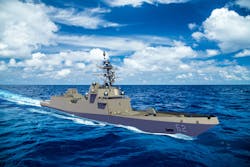Fincantieri Marinette moving forward with propulsion, shipboard electronics for Constellation-class frigate
BATH, Maine – U.S. Navy surface warfare experts are asking shipbuilder Fincantieri Marinette Marine Corp. in Marinette, Wis., to plan building a land based engineering site in Philadelphia for the future Constellation-class frigate.
Officials of the Supervisor of Shipbuilding, Conversion, and Repair, Bath, Maine, announced a $76.7 million order to Fincantieri Marinette Marine last month for procurement of long-lead time material for the land based engineering site for the Constellation-class frigate.
Orders for long-lead items are among the first steps in large procurement programs. Long-lead items either are difficult and time-consuming to obtain, and are funded early in the design process to keep overall production on schedule. Contracts to build the actual engineering center will come later.
The land-based test site in Philadelphia will test the propulsion system and other machinery of the future Constellation-class frigate design, as well as to identify and fix problems before they could cause problems in building the future frigate USS Constellation (FFG 62), which is scheduled for delivery in 2026.
Related: Navy ship building and shipboard electronics strive to do more with less
The Constellation-class frigate will replace the Navy's now-retired Oliver Hazard Perry-class frigates -- the last of which, the USS Ingraham (FFG 61), was removed from service in 2014.
Frigates typically are escort vessels that are lighter than destroyers, and help defend aircraft carrier battle groups or merchant convoys from submarine, aircraft, and cruise missile threats. They are intended to operate in the open ocean, unlike the Navy littoral combat ship, which is designed to operate in coastal waters and harbors.
The Constellation-class frigate will be able to keep up with Navy aircraft carriers and will have sensors networked with the rest of the fleet. It normally will be part of Navy strike groups and large surface combatant-led surface action groups, but also will be able to operate and defend itself in independent operations.
These frigates will have a minimum of 32 Mark 41 Vertical Launch System cells aboard for anti-air warfare. The ship will be designed to destroy surface ships over the horizon; detect enemy submarines; defend convoy ships; employ active and passive electronic warfare systems; and defend against swarming small boat attacks.
Related: U.S. Navy ships out on future force and digital transformation
Shipboard electronics will include the Lockheed Martin COMBATSS-21 combat management system; AN/SPY-6(V)3 Enterprise Air Surveillance Radar (EASR); AN/SPS-73(V)18 surface search radar; AN/SLQ-61 lightweight towed array sonar; AN/SQS-62 variable-depth sonar; AN/SQQ-89F undersea warfare and anti-submarine warfare combat system; and Cooperative Engagement Capability (CEC).
The Constellation-class frigate will accommodate 32 Vertical Launch System cells that can handle RIM-162 ESSM Block 2 and/or RIM-174 Standard ERAM missiles; RIM-66 Standard SM-2 Block 3C; the Naval Strike Missile; RIM-116 Rolling Airframe Missile; Mk 110 57-millimeter gun; and machine guns. The ship will be able to carry one MH-60R Seahawk helicopter and the MQ-8C Firescout unmanned helicopter.
The frigates will use a combined diesel electric and gas hull, mechanical and electrical propulsion system which has never been used in any other U.S. navy ship. The new propulsion system must be tested on land to reduce the risk of engine failure, which has been problematic for the Navy's Littoral Combat Ships.
The Lockheed Martin Rotary and Mission Systems segment in Moorestown, N.J., are designing the combat management system for the Constellation-class frigate. The combat system is based on the company's COMBATSS-21 ship combat management system, which is aboard the Freedom-class littoral combat ships.
Related: Shipboard electronics steams into the 21st century
COMBATSS-21 is built on an open-architecture scalable framework using non-developmental software, Lockheed Martin officials say. Custom software adapters called boundary components support sensors, communications, and weapon interfaces, and are designed to accommodate future technology insertion and system upgrades with minimal effect on the system[s core software.
In addition to developing the combat management system for the Navy's future Constellation-class frigates, Lockheed Martin also builds the Navy's Aegis combat system for Navy Arleigh Burke-class destroyers and Ticonderoga-class cruisers at its Moorestown, N.J. facility.
The Lockheed Martin COMBATSS-21 architecture isolates shipboard sensors, communications, and weapons from core components of the command and control system to avoid large system bugs and speed software certification.
COMBATSS-21 can run on computer configurations ranging from one commercial processor running a commercial operating system to more distributed configurations, to enable the COMBATSS-21 system adaptable to vessels ranging from patrol craft to large-deck ships, Lockheed Martin officials say.
Related: Navy pushes shipboard unmanned systems, lethality upgrades
The Lockheed Martin COMBATSS-21 combat management system borrows technology from Navy Aegis cruisers and destroyers, as well as the U.S. Coast Guard Deepwater program.
The future USS Constellation will be the lead ship of a class of at least 20 frigates. The hull of the frigate is be based on the Italian FREMM-class frigate. The first three ships of the class are under contract to Fincantieri Marinette Marine.
The Constellation and its first two sister ships, the USS Congress (FFG 63) and USS Chesapeake (FFG-64) are named for three of the Navy's six original frigates -- USS Chesapeake; USS Constitution; USS President; USS United States; USS Congress; and USS Constellation -- built between 1797 and 1800. Of these original ships, the USS Constitution still is a Navy commissioned warship and is based in Boston.
On this order Fincantieri Marinette Marine will do the work in Marinette, Wis., and should be finished by October 2025. For more information contact Fincantieri Marinette Marine online at https://fincantierimarinegroup.com, or the Navy Supervisor of Shipbuilding, Conversion, and Repair at www.navsea.navy.mil/Home/SUPSHIP.
About the Author
John Keller
Editor-in-Chief
John Keller is the Editor-in-Chief, Military & Aerospace Electronics Magazine--provides extensive coverage and analysis of enabling electronics and optoelectronic technologies in military, space and commercial aviation applications. John has been a member of the Military & Aerospace Electronics staff since 1989 and chief editor since 1995.
